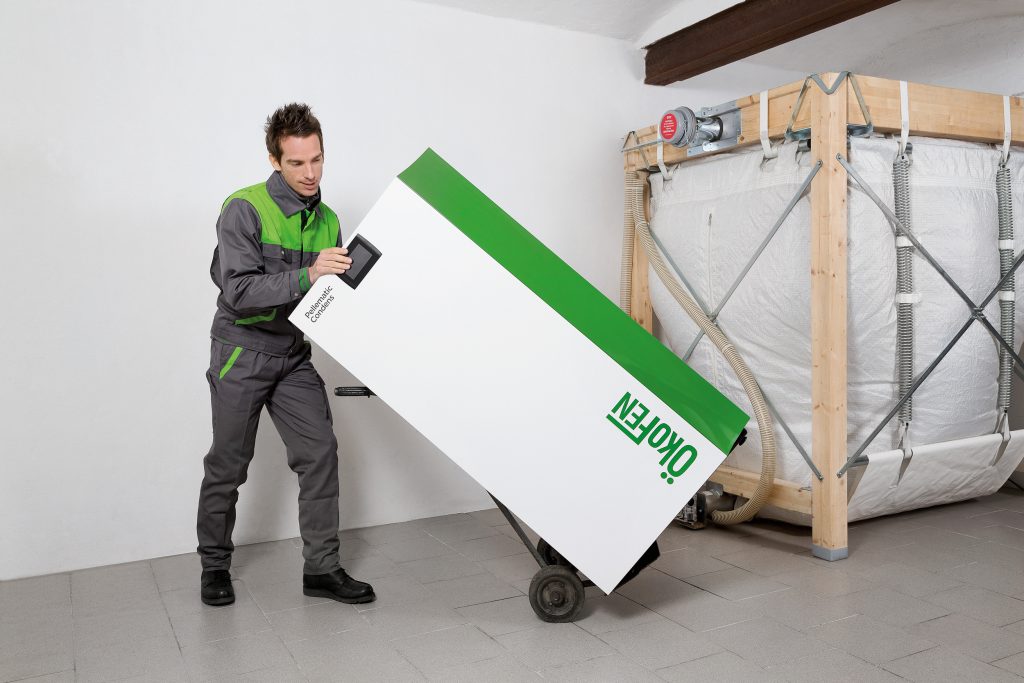
Canada’s National Standards Strategy creates path for a brighter future for wood pellets
July 28, 2022
By Dutch Dresser and Gordon Murray
 Boilers certified to EU standards come in many sizes and shapes. This one is a condensing boiler with an efficiency of about 94 per cent using the higher heating value of fuel. Photo credit: OkoFEN.
Boilers certified to EU standards come in many sizes and shapes. This one is a condensing boiler with an efficiency of about 94 per cent using the higher heating value of fuel. Photo credit: OkoFEN. Canada’s new National Standards Strategy (NSS) promises to put the full power of the standards system to work for the social and economic benefit of everyone in Canada. That’s good news for Canada’s pellet sector and Canadians who are looking to replace oil and coal with the renewable and clean energy that wood pellets can provide.
Over the past few years, we have written about the missed opportunities due to administrative barriers that restrict the sale of boiler systems that use pellets into the Canadian market. The current situation is a catch-22: we don’t make the boilers in Canada, and we can’t import them as they are manufactured, so the only significant markets for our pellets lay offshore, to be used in homes and businesses around the world as a sustainable source of renewable energy and heat. Canada’s wood pellet consumption is tiny by global standards, entirely due to the lack of access to modern highly-automated wood pellet boilers.
The barrier comes in the form of a small section of the Canadian Standards Associations requirements 4.10.1.2: of CSA B51:
“Manufacturers in countries other than Canada that manufacture and export boilers and pressure vessels to Canada shall ensure that all boilers and pressure vessels are stamped with the appropriate ASME Code product certification mark and registered with the National Board.”
The fact is Austria and Germany produce the most advanced and among the safest boiler systems in the world. To ensure public safety, these small pellet boilers are manufactured according to the European EN 303-5 boiler safety standard (biomass boilers up to 500kW output power) as well as relevant provisions of European pressure equipment directives and machinery directives. These standards are safe, effective, and are recognized in most countries, except Canada.
One of the four system priorities outlined in the Standards Council of Canada’s new strategy goes to the heart of this issue with a commitment to support facilitation of trade in goods and services through harmonized standards solutions. The NSS acknowledges what we have long maintained: Canada struggles as a federation to harmonize standards and regulations and more efforts are needed to minimize variations from national and international standards and reduce costs for consumers, industry and governments.
“Harmonized standards for the purpose of commerce have long been a driving motivation of standards activities around the world,” reads the NSS which replaces the strategy developed in 2000. “Given Canada’s dependence on international trade and trade within its borders, standards work supporting the free flow of goods and services will always be important. There continues to be a need for standards work related to (among others) … The Canada-European Union Comprehensive Economic Trade Agreement (CETA) and the Comprehensive and Progressive Agreement for Trans-Pacific Partnership (CPTPP), both of which provide for a variety of labour and other ESG standards, as well as provisions for inclusive trade to make sure benefits are widely shared in member countries.”
Guiding this work are five sector priorities, first of which is climate change mitigation, adaptation and resilience. The strategy notes that the “clock is ticking… Canada has a roadmap for substantially reducing emissions just 8 years from now.” Key areas the strategy will focus on include energy and biofuels and standards to support northern and Indigenous communities.
Wood pellets holds one of the keys to making these goals a reality. According to a recent feasibility study by M&R Engineering in Halifax, local sawdust and forest residuals could help Nova Scotia convert more than 100 public buildings to clean sustainably-produced wood pellets for heat instead of greenhouse gas (GHG) intensive oil furnace systems.
Nova Scotia’s Environmental Goals and Climate Change Reduction Act has a goal to decrease GHG emissions across government-owned buildings by 75 per cent by 2035. With heating and domestic hot water accounting for close to half of the energy use in commercial and institutional buildings in Atlantic Canada, eliminating furnace oil is essential to achieve this target.
The M&R study, funded by the Wood Pellet Association of Canada, Shaw Renewables and Nova Scotia Public Works, demonstrates that switching to a biomass fuel source will help to achieve the 75 per cent target easily as they are the cleanest fuel source with negligible emissions.
At the Wood Pellet Association of Canada, we were proud to provide input into the NSS alongside a large and diverse group of constituents and stakeholders from industry, standards development organizations, consortia, consumer groups, government, and academia. This input combined with the goals of the NSS will now guide the work of a small group of experts who are currently framing the argument for Provincial-Territorial Advisory Committee (PTAC) for the development of a new Canadian standard that would closely follow Europe’s EN 303-5 for boilers. It paves the way for Canadians to have access to both clean, renewable domestic energy in the form of wood pellets and the associated infrastructure required to make this a reality.
Harry “Dutch” Dresser, Ed.D., is a biomass heating expert and consultant. Gordon Murray is the executive director of the Wood Pellet Association of Canada.
Print this page